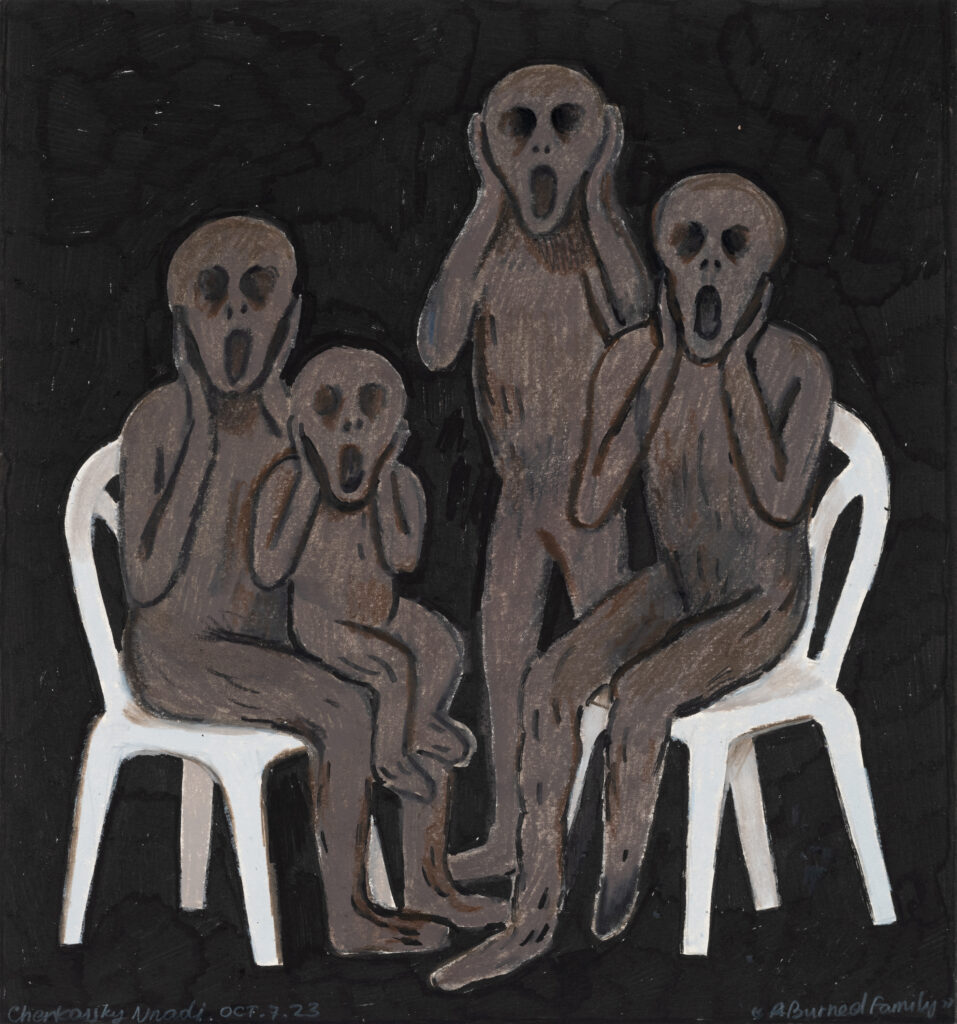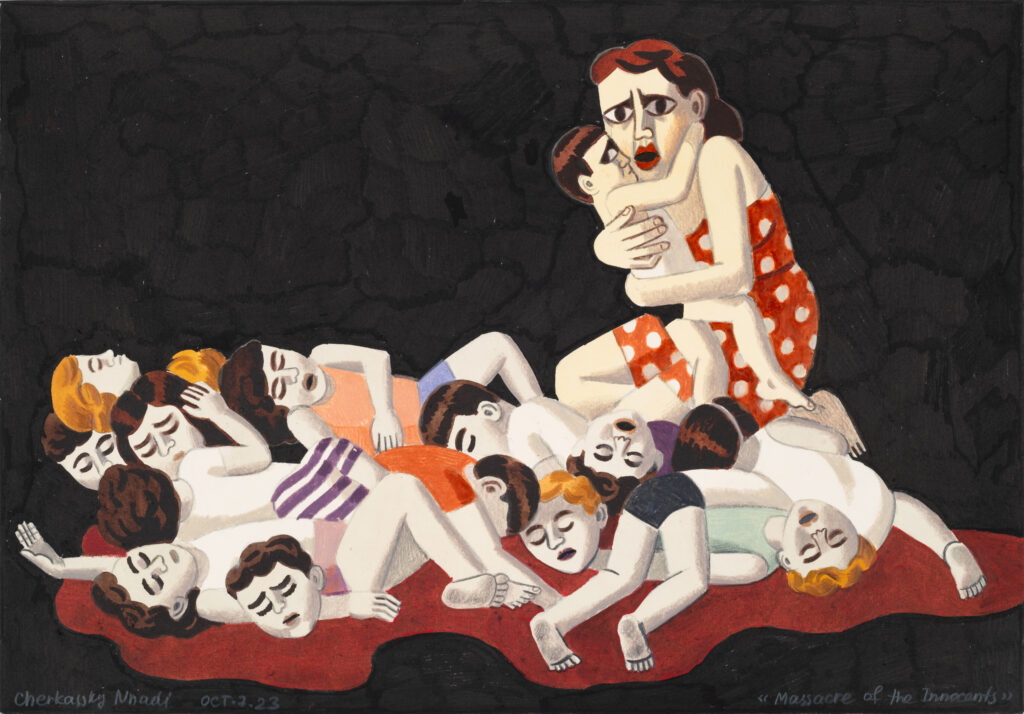An ‘Israeli Guernica,’ at the Jewish Museum, Bears Witness to October 7
A series of searing paintings gives Israelis the dignity of their suffering in a world that too often denies it.

‘7 October 2023 Series’
Through February 19
The Jewish Museum
1109 Fifth Ave., NYC
The “7 October 2023 Series,” a searing show by Zoya Cherkassky at the Jewish Museum, is an artistic rapid response to the worst disaster to have befallen the Jews since the Holocaust. Ms. Cherkassky, an Israeli artist born at Kyiv who came to the Jewish state as the Soviet Union collapsed, has created a set of 12 scenes depicting various angles on the horror of Hamas’s attack. They are graphic in multiple senses — explicit, vivid, and expressive.
Painted in bright colors against pitch-black backgrounds, each scene makes its case for moral attention in stark terms, like images sourced from a nightmare children’s book. Ms. Cherkassky’s range of reference is eclectic, spanning socialist realism, the 20th century avant garde, and medieval masters. This, though, is not art for art’s sake, nor intended just for patrons and professors. These pictures make art’s pretension appear preposterous.
“The Israeli Guernica” is how Ms. Cherkassky describes the images of death and destruction that staggered out of Kibbutz Be’eri after October 7. The murder of 1,200, the taking of hundreds as hostages, the thousands maimed and wounded — she reflects that it is “something that we didn’t believe could happen in Israel, and in such a brutal way.”
“7 October” is a report of that brutality, rendered in crayons, watercolors, and colored pencils. The photographic sources of these images, whether privately screened by the Israel Defense Forces or circulated online, are shorthands for atrocity. Many were taken by the perpetrators themselves. Ms. Cherkassky gives Israelis the dignity of their suffering in a world that too often denies it.
“Kidnapped Women” shows a procession of the taken, of all ages. Something about it echoes the forlorn of Jerusalem, captured on the Arch of Titus at Rome. They are staggering rightward, to the picture’s edge, as if they soon will disappear over Gaza’s edge. “Crying Female Soldiers” reminds that these women of valor in fatigues and guns were powerless to stop the kind of ravagings that the IDF are meant to obviate.

paper. Artwork © Zoya Cherkassky, via the artist and Fort Gansevoort, New York.
“Breakfast in Ashes” surfaces the domestic setting of so much of the horrors. In it, a family sits at a table. Ashes cover the table and floor, thick as salt at the Dead Sea. The biblical tradition of sackcloth and ash is one allusion, but the inspiration is closer at hand — the transformation of hearths and homes into scenes of surreal violence, the translation of buildings and bodies into flaky fragments of ash.
This line of thinking is extended in “A Burned Family,” where figures modeled on the Norwegian painter Edvard Munch’s “The Scream” gather in perpetual lament, their hands to their heads to telegraph a permanent wail and a chorus of catastrophe. “The Survivor” is no less horrifying for it featuring one of the living — blood pools on the floor, flames course in the background, and the bodies of the slain are bound and butchered.
“Massacre of the Innocents” likewise features a tangle of corpses, and also an improbable echo. The name is taken from a story attested to in the Gospel of Matthew, when King Herod of Judea orders the male boys near Bethlehem killed. That tale in turn inspired the 14th century Italian painter, Giotto, who completed a luminous painting of the same name, now at Padua. Ms. Cherkassy reaches for the Old Master for language to express fresh horror.

crayon on paper. © Zoya Cherkassky, via the artist and Fort Gansevoort, New York
In all of these paintings, the casual details of the clothes — jeans and crop tops, dresses and shorts — convey the sinister surprise of the assault: Nobody woke up that Saturday expecting to die. No painting captures that all-of-a-sudden terror like “The Terrorist Attack at Nova Music Festival.” Ms. Cherkassky paints chaos: bodies in motion, fallen bodies, the blur of beautiful people running from barbarism. A dance of death.
“Raped and Butchered” and “Grandma and Grandpa” depict crimes against the most vulnerable. If these 12 images, though, are difficult to bear, it is worth recalling that this small room on Manhattan’s Fifth Avenue gestures toward a still grieving and warring Zion. One hopes that “October 7” will start at the Jewish Museum, but not end there.

